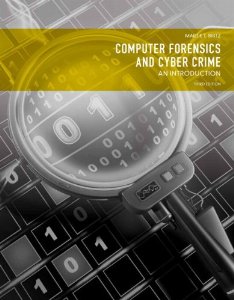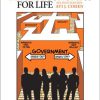Test Bank for Computer Forensics and Cyber Crime An Introduction 3rd Edition Marjie T Britz Download
$35.00 Original price was: $35.00.$26.50Current price is: $26.50.
Test Bank for Computer Forensics and Cyber Crime An Introduction 3rd Edition Marjie T Britz Download
Sell by: Jason Gray
SKU: rwkoz457748
Category: Test Bank
Instant download Test Bank for Computer Forensics and Cyber Crime An Introduction 3rd Edition Marjie T Britz Download pdf docx epub after payment.

Product details:
ISBN – 10: 9780133036091
ISBN – 13: 013303609X
Author: Marjie T. Britz
This is the eBook of the printed book and may not include any media, website access codes, or print supplements that may come packaged with the bound book.The leading introduction to computer crime and forensicsis now fully updated to reflect today’s newest attacks, laws, and investigatory best practices. Packed with new case studies, examples, and statistics, Computer Forensics and Cyber Crime, Third Edition adds up-to-the-minute coverage of smartphones, cloud computing, GPS, Mac OS X, Linux, Stuxnet, cyberbullying, cyberterrorism, search and seizure, online gambling, and much more. Covers all forms of modern and traditional computer crime, defines all relevant terms, and explains all technical and legal concepts in plain English, so students can succeed even if they have no technical, legal, or investigatory background.
Table Of Contents:
- Chapter 1 INTRODUCTION AND OVERVIEW OF COMPUTER FORENSICS AND CYBERCRIME
- I. Introduction
- II. Cyberspace and Criminal Behavior
- III. Clarification of Terms
- IV. Traditional Problems Associated with Computer Crime
- a. Physicality and Jurisdictional Concerns
- b. Perceived Insignificance, Stereotypes, and Incompetence
- c. Prosecutorial Reluctance
- d. Lack of Reporting
- e. Lack of Resources
- f. Jurisprudential Inconsistency
- V. Extent of the Problem
- VI. The Emergence of e-Cash: A New Problem for Law Enforcement
- a. Prepaid Cards
- b. Stored Value Cards
- c. Mobile Payments
- d. Internet Payment Services
- e. Digital Precious Metals
- VII. Conclusions
- Discussion Questions
- Recommended Reading
- Web Resources
- Endnotes
- Chapter 2 COMPUTER TERMINOLOGY AND HISTORY
- I. A Brief History of Computers
- II. Computer Language
- a. Understanding Data
- III. Computer Hardware
- a. Input Devices
- b. Output Devices
- c. Hard Drives and Other Mass Storage Devices
- IV. Computer Software
- a. Boot Sequence
- b. Operating System
- V. Beyond DOS: Contemporary Operating Systems
- a. Microsoft Windows
- b. Macintosh
- c. UNIX
- d. LINUX
- e. Smart Phones
- VI. Application Software
- VII. A Brief History of the Internet
- VIII. Network Language
- a. Commonly Used Terms
- IX. Realms of the Cyberworld
- X. Data Bandwith Transfer Rates
- XI. Categorizing Internet Communication
- a. World Wide Web
- b. Newsgroups/Bulletin Boards (Usenet Groups)
- c. Internet Relay Chat
- XII. Future Issues and Conclusions
- Discussion Questions
- Recommended Reading
- Web Resources
- Endnotes
- Chapter 3 TRADITIONAL COMPUTER CRIME: EARLY HACKERS AND THEFT OF COMPONENTS
- I. Introduction
- II. Traditional Problems
- III. Recognizing and Defining Computer Crime
- IV. Three Incidents
- V. Phreakers: Yesterday’s Hackers
- a. What Is Phreaking?
- b. The War on Phreaking
- VI. Hacking
- a. Defining Hacking
- b. Evolution in the Hacking Community
- c. Contemporary Motivation
- d. Hierarchy of Contemporary Cybercriminals
- VII. Computers as Commodities
- a. Hardware
- VIII. Theft of Intellectual Property
- a. Software
- b. Film Piracy
- XI. Conclusions
- Discussion Questions
- Recommended Reading
- Web Resources
- Endnotes
- Chapter 4 CONTEMPORARY COMPUTER CRIME
- I. Web-Based Criminal Activity
- a. Interference with Lawful Use of Computers
- II. Malware
- a. Viruses and Worms
- b. DoS and DDoS Attacks
- c. Botnets and Zombie Armies
- d. Spam
- e. Ransomware and the Kidnapping of Information
- III. Theft of Information, Data Manipulation, and Web Encroachment
- a. Traditional Methods of Proprietary Information Theft
- b. Trade Secrets and Copyrights
- c. Political Espionage
- IV. Terrorism
- a. Cyberterrorism
- V. Neotraditional Crime: Old Wine in New Bottles
- a. Dissemination of Contraband or Offensive Materials
- b. Threatening and Harassing Communications
- c. Online Fraud
- d. e-Fencing
- e. Fraudulent Instruments
- VI. Ancillary Crimes
- a. Money Laundering
- VII. Conclusions
- Discussion Questions
- Recommended Reading
- Web Resources
- Endnotes
- Chapter 5 IDENTITY THEFT AND IDENTITY FRAUD
- I. Introduction
- II. Typologies of Identity Theft/Fraud
- a. Assumption of Identity
- b. Theft for Employment and/or Border Entry
- c. Criminal Record Identity Theft/Fraud
- d. Virtual Identity Theft/Fraud
- e. Credit Identity Theft/Fraud
- III. Prevalence and Victimology
- a. Victims and the Costs Associated with Victimization
- b. Future Increases
- IV. Physical Methods of Identity Theft
- a. Mail Theft
- b. Dumpster Diving
- c. Theft of Computers
- d. Bag Operations
- e. Child Identity Theft
- f. Insiders
- g. Fraudulent or Fictitious Companies
- h. Card Skimming, ATM Manipulation, and Fraudulent Machines
- V. Virtual or Internet-Facilitated Methods
- a. Phishing
- b. Spyware and Crimeware
- c. Keyloggers and Password Stealers
- d. Trojans
- VI. Crimes Facilitated by Identity Theft/Fraud
- a. Insurance and Loan Fraud
- b. Immigration Fraud and Border Crossings
- VII. Conclusions and Recommendations
- Discussion Questions
- Recommended Reading
- Web Resources
- Endnotes
People also search:
|
computer forensics and cyber crime an introduction
|
computer forensics and cyber crime an introduction pdf
|
what is computer forensics in cyber security
|
computer forensics examples
what is computer forensics
Related products
Sale!
Sell by: Michael Johnson
Sale!
Sell by: Madison Foster
Sale!
Sell by: Trevor Lawrence
Sale!
Sell by: Joshua Sanchez
Sale!
Sell by: Gavin Barrett
Sale!
Sell by: Ellie Graham
Sale!
Sell by: Spencer Lowe
Sale!
Sell by: Anthony Campbell











